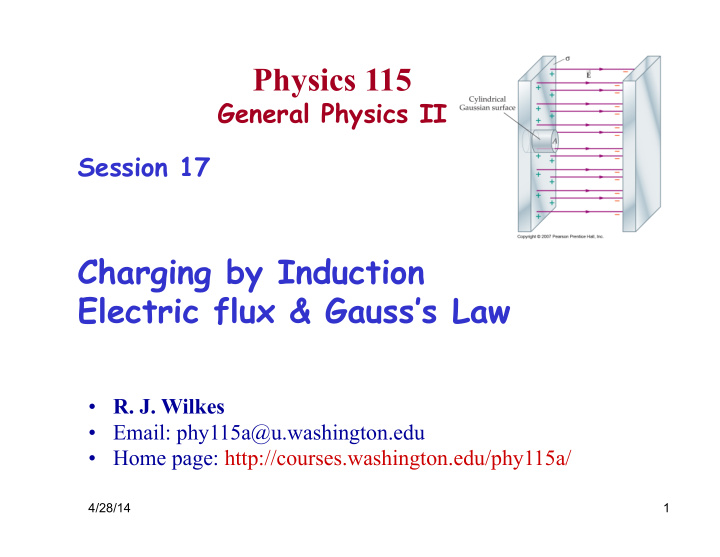



Physics 115 General Physics II Session 17 Charging by Induction Electric flux & Gauss’s Law • R. J. Wilkes • Email: phy115a@u.washington.edu • Home page: http://courses.washington.edu/phy115a/ 4/28/14 1
Lecture Schedule (up to exam 2) Today Minor revisions to calendar – almost caught up... 4/28/14 Physics 115 2
E field of a sheet of charge • If a thin sheet carries uniformly distributed charge the E field will be uniform and perpendicular to the sheet – For a sheet in the y-z plane, consider E field at a point on the x axis: For contributions to E from Δ q’s symmetrically located at + y • x components add • y components cancel • Result: uniform E pointing out (if +q) – Except near edges: symmetry ends there! – “infinite sheet” approximation... – NOTICE: E does not diminish with distance! • Field lines are parallel – same density everywhere 4/28/14 3 Physics 115
Parallel oppositely charged plates = “capacitor” • Consider 2 parallel (infinite) conducting plates, separation d, one has +q and the other has –q • In the gap, E field is uniform (constant magnitude and direction) and perpendicular to plates – Capacitors have many useful properties • important in physics and technology – We’ll come back to study them later 4/28/14 4 Physics 115
Quiz 10 For an infinite sheet of charge: How does the magnitud e of the E field compare at the points shown? (field map shown is accurate) (A) All points have different field magnitudes (B) Field at a is larger, but other points are equal (C) All points have equal field magnitudes (D) Point a is smallest, but other points are equal (E) Cannot answer without more information. 4/28/14 5 Physics 115
Charging by induction Last time Charge separation by induction: • Hold charged rod near metal object – (not in contact – no direct transfer of q) • Rod’s q attracts opposite charge within conductor • same-sign charge is repelled – and left behind • Conductor’s net charge is still zero but E field of rod has caused charge separation • Field set up between separated q inside conductor cancels external field from rod 4/28/14 6
Charging by Induction (2) • Two uncharged metal spheres touch each other, forming a single conductor. • Bring a positively charged rod near (but never touching) one sphere • The + charged rod attracts electrons • Induction: • Near sphere gets a net negative charge • Far sphere gets an equal net positive charge. • Now separate the spheres: The near one has negative and the far one has positive charge. 4/28/14 7 7
Induction via Grounding a) A single neutral conducting sphere is polarized by the positively charged rod, which attracts negative charges b) The conductor is grounded by connecting a wire to the Earth, which acts like a gigantic conductor c) Electrons from the ground neutralize the positive charge on the far face. The conductor is left negatively charged. (somewhere within the Earth there is a bit of extra negative charge) d) The negative charge remains if the connection to the ground is broken before the rod is removed. e) After the rod is removed, the sphere has a uniform negative charge. 4/28/14 8 8
BTW: E fields can polarize insulators In insulators, external charge’s E field can distort the distribution of electrons, producing an asymmetry in the atoms that makes one end +, the other – . On average, there will be a net force on the object. (Notice the electrons do not separate from the nuclei, as in a conductor) – + + Some materials have polar molecules: water molecule 4/28/14 9
Electric flux • Michael Faraday (Britain, 1840s): Electric forces are due to a “flow”, electric flux Φ – Superseded by modern E field concept, but useful; flux can E ⋅ A be connected to real physical quantities: we define Φ E = – A means area of a surface, taking into account its angle relative to the E field direction • What direction should we assign the vector? • The only unique direction wrt a plane is perpendicular • Define a unit vector normal (perpendicular) to surface, n – then A ≡ A ˆ n Deep thought: how do we choose which direction perpendicular to surface ? (we could reverse n ) Here, we choose direction where E has a parallel component This will come up again... 4/28/14 10
Electric flux a) If A is perpendicular to E, then Φ = EA b) If A is parallel to E, then Φ = 0 c) For other angles, the dot product gives: E ⋅ A = E A cos θ Φ E = For a closed surface, add up ΔΦ contributions from all parts for simple shapes it may be easy, otherwise use calculus • 4/28/14 11
Fluid flow analogy for flux • Imagine air flowing through an area defined by a loop of wire: recall fluid flux = A v – Maximum flow if loop is perpendicular to airflow – Zero if loop is parallel – At other angles, airflow is given by dot product of v and A Φ AIR = v ⋅ A = vA cos θ • Notice symmetry of dot product: we can say it is “(component of v perpendicular to A) times (A)”, OR “(v) times (component of A perpendicular to v)” 4/28/14 12
Recommend
More recommend